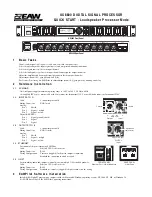
What if the first input signal has many harmonics? In that case, the ring modulator
output contains the sum and difference frquencies between all the harmonics of the
first input, and the single frequency of the second input. Figures 7 and 8 show what
happens when the first input is a 500 Hz square wave and the second input is a 100 Hz
sine wave. Figure 7 shows the waveform and spectrum of a 500 Hz square wave. This
waveform has only odd harmonics. The first harmonic (usually called the fundamental)
is 500 Hz, the third harmonic is 1,500 Hz, the fifth harmonic is 2,500 Hz, and so on. This
set of harmonics produces a tone that sounds bright and hollow. When this waveform is
ring-modulated by a 100 Hz sine wave, the resultant spectrum contains components
whose frequencies are 400 Hz, 600 Hz, 1,400 Hz, 1,600 Hz, 2,400 Hz, 2,600 Hz, and so
on. Figure 8 shows the waveform and spectrum of the ring modulation of a 500 Hz
square wave by a 100 Hz sine wave.
Figure 7 - Waveform and spectrum of a 500 Hz. square wave
Figure 8: Waveform and spectrum of a 500 Hz
square wave ring-modulated by a 100 Hz sine
wave.
WHAT IS THE CARRIER OSCILLATOR?
Your MF-102 contains a wide-range, voltage-controlled oscillator that produces a sine-
like waveform. We call this the carrier oscillator because, like the carrier of an AM
signal, it’s always there, ready to be modulated by any sound that you play. The carrier
oscillator is connected to the second input of the ring modulator circuit through the
bridging connection of the CARRIER IN jack on the rear panel. Thus, if you do not plug
anything into this jack, then your MF-102’s carrier oscillator is automatically connected
to the second input of the ring modulator. The carrier oscillator’s frequency is
determined by the setting of the FREQUENCY knob and the LO-HI switch above it. The
carrier oscillator frequency range extends from 0.6 Hz to 80 Hz on the LO setting of the
switch, and from 30 Hz to 4 kHz on the HI setting of the switch.

































